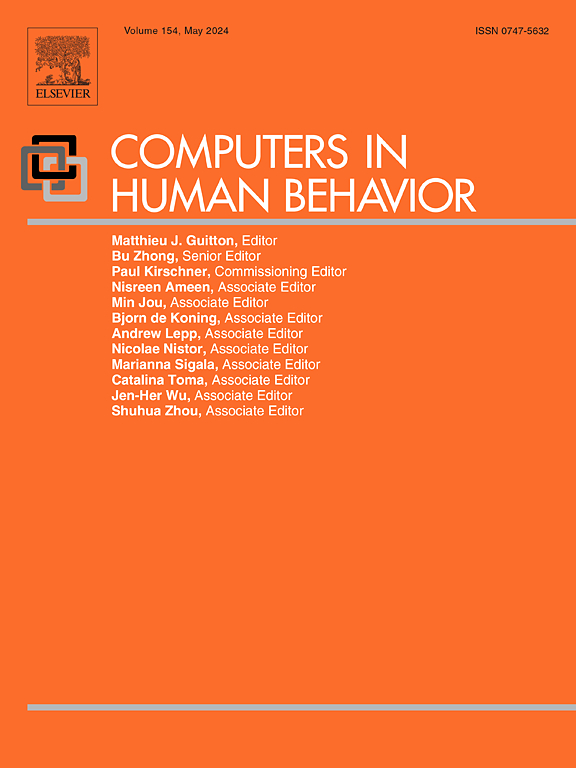通过密集的智能手机纵向跟踪调查智能手机使用问题背后的智能手机使用特征
IF 8.9
1区 心理学
Q1 PSYCHOLOGY, EXPERIMENTAL
引用次数: 0
摘要
越来越多的证据表明,有问题的智能手机使用会导致心理健康和生活质量受损。我们进行了一项为期60天的智能手机纵向跟踪研究,使用一款应用程序捕捉智能手机的日常使用情况。根据智能手机成瘾量表-短版本(SAS-SV), 186人被纳入研究,并被分为问题智能手机用户(psu, n = 86)和无问题智能手机用户(USUs, n = 100)。在基线时评估社会人口统计数据、心理健康和生活质量。通过使用线性混合效应模型(lmm),我们分析了时间、群体(PSU vs. USU)、性别和时间×群体互动对智能手机和应用类别(即通信、社交和游戏应用)的每日总使用量的影响。总体而言,参与者每天使用智能手机3.7小时,psu的每日使用时间(4.2小时)高于usu(3.3小时)。这些群体差异也存在于日常使用通信和社交应用程序中,以及性别对任何应用程序的日常总使用量的显著影响(F(1189) = 5.06, p = 0.026)。二次性别分层分析显示,男性psu使用智能手机的次数明显多于女性(F(1,106.15) = 12.06, p < 0.001)和社交应用使用(F(1,105.44) = 9.23, p = 0.003)。在女性中,发现的唯一组差异是在通信应用程序类别中,psu的日常使用率更高(F(1,97.34) = 6.50, p = 0.012)。然而,两种性别的PSU患者在基线时的生活质量较低,抑郁程度较高,这与PSU严重程度显著相关(均r >; 0.22,均p <; 0.041)。本文章由计算机程序翻译,如有差异,请以英文原文为准。
Investigation of smartphone use characteristics underlying problematic smartphone use by dense longitudinal smartphone tracking
Growing evidence suggests problematic smartphone use can lead to impaired mental health and quality of life. We conducted a 60-day longitudinal smartphone tracking study using an app capturing daily smartphone use. 186 individuals were enrolled and classified as problematic (PSUs, n = 86) or unproblematic smartphone users (USUs, n = 100), based on the Smartphone Addiction Scale – Short Version (SAS-SV). Sociodemographic data, mental health and quality of life were assessed at baseline. Using linear mixed effects models (LMMs), primary analyses examined the effects of time, group (PSU vs. USU), gender, and time × group interactions on daily total smartphone and app category use i.e. communication, social and gaming apps. Overall, participants used their smartphones for 3.7 h per day, with higher daily use in PSUs (4.2 h) compared to USUs (3.3 h). These group differences were also present in daily use of communication and social apps, alongside a significant effect of gender on daily total use of any app (F(1,189) = 5.06, p = 0.026). Secondary gender-stratified analyses showed that male PSUs used their smartphones significantly more than USUs in both total (F(1,106.15) = 12.06, p < 0.001) and social app use (F(1,105.44) = 9.23, p = 0.003). In females, the only group difference found was in the communication app category, with higher daily use in PSUs (F(1,97.34) = 6.50, p = 0.012). Nevertheless, PSUs of both genders reported lower quality of life and higher levels of depressiveness at baseline, which significantly correlated with PSU severity (all r > 0.22, all p < 0.041).
求助全文
通过发布文献求助,成功后即可免费获取论文全文。
去求助
来源期刊

Computers in Human Behavior
Multiple-
CiteScore
19.10
自引率
4.00%
发文量
381
审稿时长
40 days
期刊介绍:
Computers in Human Behavior is a scholarly journal that explores the psychological aspects of computer use. It covers original theoretical works, research reports, literature reviews, and software and book reviews. The journal examines both the use of computers in psychology, psychiatry, and related fields, and the psychological impact of computer use on individuals, groups, and society. Articles discuss topics such as professional practice, training, research, human development, learning, cognition, personality, and social interactions. It focuses on human interactions with computers, considering the computer as a medium through which human behaviors are shaped and expressed. Professionals interested in the psychological aspects of computer use will find this journal valuable, even with limited knowledge of computers.
 求助内容:
求助内容: 应助结果提醒方式:
应助结果提醒方式:


